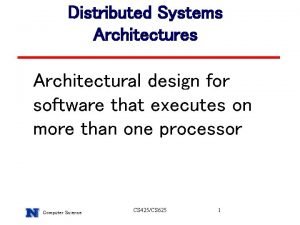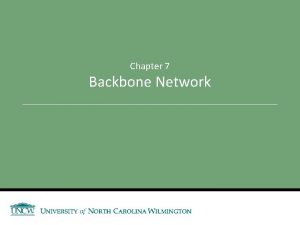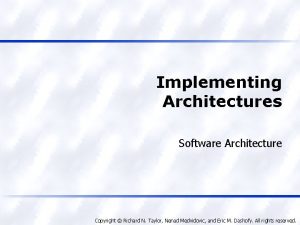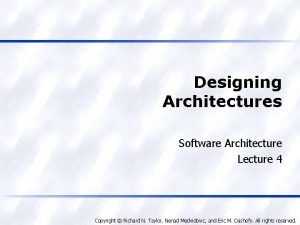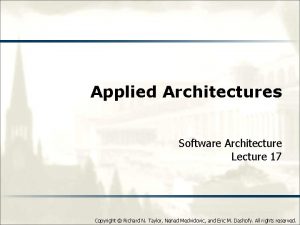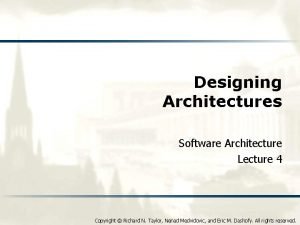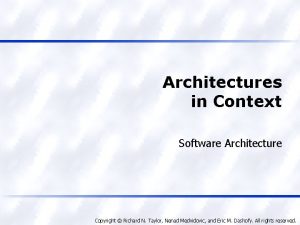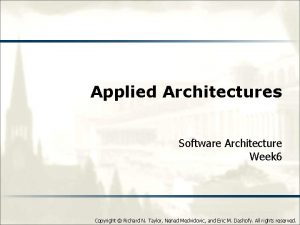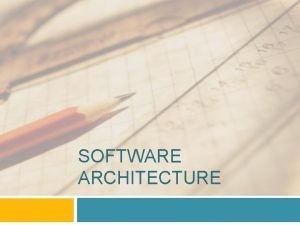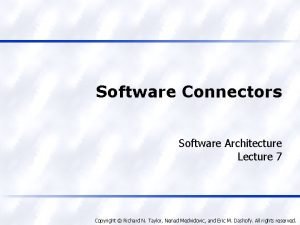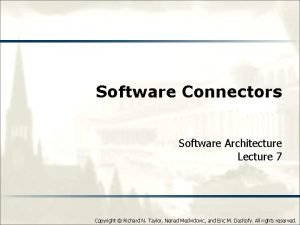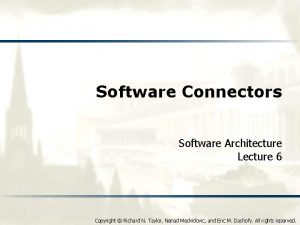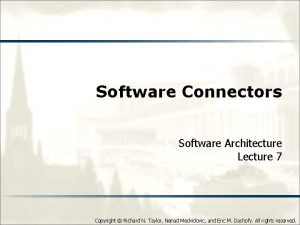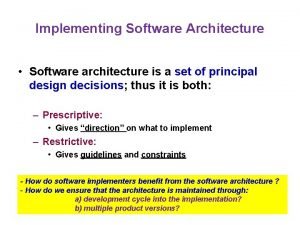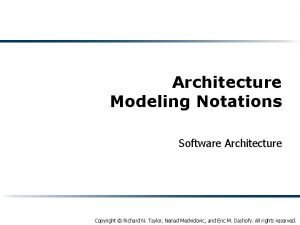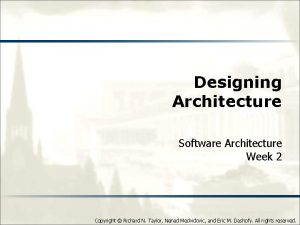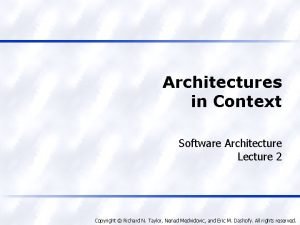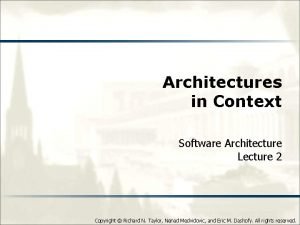Implementing Architectures Software Architecture Lecture 15 Copyright Richard































- Slides: 31

Implementing Architectures Software Architecture Lecture 15 Copyright © Richard N. Taylor, Nenad Medvidovic, and Eric M. Dashofy. All rights reserved.

Software Architecture: Foundations, Theory, and Practice Objectives l l l Concepts u Implementation as a mapping problem u Architecture implementation frameworks u Evaluating frameworks u Relationships between middleware, frameworks, component models u Building new frameworks u Concurrency and generative technologies u Ensuring architecture-to-implementation consistency Examples u Different frameworks for pipe-and-filter u Different frameworks for the C 2 style Application u Implementing Lunar Lander in different frameworks 2

Software Architecture: Foundations, Theory, and Practice Objectives l l l Concepts u Implementation as a mapping problem u Architecture implementation frameworks u Evaluating frameworks u Relationships between middleware, frameworks, component models u Building new frameworks u Concurrency and generative technologies u Ensuring architecture-to-implementation consistency Examples u Different frameworks for pipe-and-filter u Different frameworks for the C 2 style Application u Implementing Lunar Lander in different frameworks 3

Software Architecture: Foundations, Theory, and Practice The Mapping Problem l l Implementation is the one phase of software engineering that is not optional Architecture-based development provides a unique twist on the classic problem u It becomes, in large measure, a mapping activity Design Decisions l Implementation Artifacts Maintaining mapping means ensuring that our architectural intent is reflected in our constructed systems 4

Software Architecture: Foundations, Theory, and Practice Common Element Mapping l l Components and Connectors u Partitions of application computation and communication functionality u Modules, packages, libraries, classes, explicit components/connectors in middleware Interfaces u Programming-language level interfaces (e. g. , APIs/function or method signatures) are common u State machines or protocols are harder to map 5

Software Architecture: Foundations, Theory, and Practice Common Element Mapping (cont’d) l l Configurations u Interconnections, references, or dependencies between functional partitions u May be implicit in the implementation u May be externally specified through a MIL and enabled through middleware u May involve use of reflection Design rationale u Often does not appear directly in implementation u Retained in comments and other documentation 6

Software Architecture: Foundations, Theory, and Practice Common Element Mapping (cont’d) l l Dynamic Properties (e. g. , behavior): u Usually translate to algorithms of some sort u Mapping strategy depends on how the behaviors are specified and what translations are available u Some behavioral specifications are more useful for generating analyses or testing plans Non-Functional Properties u Extremely difficult to do since non-functional properties are abstract and implementations are concrete u Achieved through a combination of human-centric strategies like inspections, reviews, focus groups, user studies, beta testing, and so on 7

Software Architecture: Foundations, Theory, and Practice One-Way vs. Round Trip Mapping l l Architectures inevitably change after implementation begins u For maintenance purposes u Because of time pressures u Because of new information Implementations can be a source of new information u We learn more about the feasibility of our designs when we implement u We also learn how to optimize them Design Decisions Implementation Artifacts 8

Software Architecture: Foundations, Theory, and Practice One-Way vs. Round Trip Mapping (cont’d) l l l Keeping the two in sync is a difficult technical and managerial problem u Places where strong mappings are not present are often the first to diverge One-way mappings are easier u Must be able to understand impact on implementation for an architectural design decision or change Two way mappings require more insight u Must understand how a change in the implementation impacts architecture-level design decisions 9

Software Architecture: Foundations, Theory, and Practice One-Way vs. Round Trip Mapping (cont’d) l l One strategy: limit changes u If all system changes must be done to the architecture first, only one-way mappings are needed u Works very well if many generative technologies in use u Often hard to control in practice; introduces process delays and limits implementer freedom Alternative: allow changes in either architecture or implementation u Requires round-trip mappings and maintenance strategies u Can be assisted (to a point) with automated tools 10

Software Architecture: Foundations, Theory, and Practice Architecture Implementation Frameworks l Ideal approach: develop architecture based on a known style, select technologies that provide implementation support for each architectural element OO Class Design Decisions Software Library Database 11

Software Architecture: Foundations, Theory, and Practice Architecture Implementation Frameworks l l This is rarely easy or trivial u Few programming languages have explicit support for architecture-level constructs u Support infrastructure (libraries, operating systems, etc. ) also has its own sets of concepts, metaphors, and rules To mitigate these mismatches, we leverage an architecture implementation framework 12

Software Architecture: Foundations, Theory, and Practice Architecture Implementation Frameworks l Definition: An architecture implementation framework is a piece of software that acts as a bridge between a particular architectural style and a set of implementation technologies. It provides key elements of the architectural style in code, in a way that assists developers in implementing systems that conform to the prescriptions and constraints of the style. F r a m e w o r k 13

Software Architecture: Foundations, Theory, and Practice Canonical Example l The standard I/O (‘stdio’) framework in UNIX and other operating systems u Perhaps the most prevalent framework in use today u Style supported: pipe-and-filter u Implementation technologies supported: concurrent process-oriented operating system, (generally) nonconcurrent language like C 14 Software Architecture: Foundations, Theory, and Practice ; Richard N. Taylor, Nenad Medvidovic, and Eric M. Dashofy; ゥ 2008 John Wiley & Sons, Inc. Reprinted with permission.

Software Architecture: Foundations, Theory, and Practice More on Frameworks l l l Frameworks are meant to assist developers in following a style u But generally do not constrain developers from violating a style if they really want to Developing applications in a target style does not require a framework u But if you follow good software engineering practices, you’ll probably end up developing one anyway Frameworks are generally considered as underlying infrastructure or substrates from an architectural perspective u You won’t usually see the framework show up in an architectural model, e. g. , as a component 15

Software Architecture: Foundations, Theory, and Practice Same Style, Different Frameworks l l For a given style, there is no one perfect architecture framework u Different target implementation technologies induce different frameworks l stdio vs. iostream vs. java. io Even in the same (style/target technology) groupings, different frameworks exist due to different qualitative properties of frameworks u java. io vs. java. nio u Various C 2 -style frameworks in Java 16

Software Architecture: Foundations, Theory, and Practice Evaluating Frameworks l l l Can draw out some of the qualitative properties just mentioned Platform support u Target language, operating system, other technologies Fidelity u How much style-specific support is provided by the framework? l Many frameworks are more general than one target style or focus on a subset of the style rules u How much enforcement is provided? 17

Software Architecture: Foundations, Theory, and Practice Evaluating Frameworks (cont’d) l l Matching Assumptions u Styles impose constraints on the target architecture/application u Frameworks can induce constraints as well l E. g. , startup order, communication patterns … u To what extent does the framework make too many (or too few) assumptions? Efficiency u Frameworks pervade target applications and can potentially get involved in any interaction u To what extent does the framework limit its slowdown and provide help to improve efficiency if possible (consider buffering in stdio)? 18

Software Architecture: Foundations, Theory, and Practice Evaluating Frameworks (cont’d) l Other quality considerations u Nearly every other software quality can affect framework evaluation and selection l Size l Cost l Ease of use l Reliability l Robustness l Availability of source code l Portability l Long-term maintainability and support 19

Software Architecture: Foundations, Theory, and Practice Middleware and Component Models l l This may all sound similar to various kinds of middleware/component frameworks u CORBA, COM/DCOM, Java. Beans, . NET, Java Message Service (JMS), etc. They are closely related u Both provide developers with services not available in the underlying OS/language u CORBA provides well-defined interfaces, portability, remote procedure call… u Java. Beans provides a standardized packaging framework (the bean) with new kinds of introspection 20 and binding

Software Architecture: Foundations, Theory, and Practice Middleware and Component Models (cont’d) l l Indeed, architecture implementation frameworks are forms of middleware u There’s a subtle difference in how they emerge and develop u Middleware generally evolves based on a set of services that the developers want to have available l E. g. , CORBA: Support for language heterogeneity, network transparency, portability u Frameworks generally evolve based on a particular architectural style that developers want to use Why is this important? 21

Software Architecture: Foundations, Theory, and Practice Middleware and Component Models (cont’d) l l By focusing on services, middleware developers often make other decisions that substantially impact architecture E. g. , in supporting network transparency and language heterogeneity, CORBA uses RPC u But is RPC necessary for these services or is it just an enabling technique? In a very real way, middleware induces an architectural style u CORBA induces the ‘distributed objects’ style u JMS induces a distributed implicit invocation style Understanding these implications is essential for not having major problems when the tail wags the dog! 22

Software Architecture: Foundations, Theory, and Practice Resolving Mismatches l l l A style is chosen first, but the middleware selected for implementation does not support (or contradicts) that style A middleware is chosen first (or independently) and has undue influence on the architectural style used Strategies u Change or adapt the style u Change the middleware selected u Develop glue code Use the middleware u Leverage parts of the middleware as the basis for and ignore others a framework u Hide the middleware in components/connectors 23

Software Architecture: Foundations, Theory, and Practice Hiding Middleware in Connectors Comp 1 Architecture Comp 1 (thread) Async Event RPC (thread) Implementation Comp 2 24

Software Architecture: Foundations, Theory, and Practice Building a New Framework l l Occasionally, you need a new framework u The architectural style in use is novel u The architectural style is not novel but it is being implemented on a platform for which no framework exists u The architectural style is not novel and frameworks exist for the target platform, but the existing frameworks are inadequate Good framework development is extremely difficult u Frameworks pervade nearly every aspect of your system u Making changes to frameworks often means changing the entire system u A task for experienced developers/architects 25

Software Architecture: Foundations, Theory, and Practice New Framework Guidelines l l Understand the target style first u Enumerate all the rules and constraints in concrete terms u Provide example design patterns and corner cases Limit the framework to the rules and constraints of the style u Do not let a particular target application’s needs creep into the framework u “Rule of three” for applications 26

Software Architecture: Foundations, Theory, and Practice New Framework Guidelines (cont’d) l l Choose the framework scope u A framework does not necessarily have to implement all possible stylistic advantages (e. g. , dynamism or distribution) Avoid over-engineering u Don’t add capabilities simply because they are clever or “cool”, especially if known target applications won’t use them u These often add complexity and reduce performance 27

Software Architecture: Foundations, Theory, and Practice New Framework Guidelines (cont’d) l l Limit overhead for application developers u Every framework induces some overhead (classes must inherit from framework base classes, communication mechanisms limited) u Try to put as little overhead as possible on framework users Develop strategies and patterns for legacy systems and components u Almost every large application will need to include elements that were not built to work with a target framework u Develop strategies for incorporating and wrapping these 28

Software Architecture: Foundations, Theory, and Practice Concurrency l l l Concurrency is one of the most difficult concerns to address in implementation u Introduction of subtle bugs: deadlock, race conditions… u Another topic on which there are entire books written Concurrency is often an architecture-level concern u Decisions can be made at the architectural level u Done carefully, much concurrency management can be embedded into the architecture framework Consider our earlier example, or how pipe-and-filter architectures are made concurrent without direct user involvement 29

Software Architecture: Foundations, Theory, and Practice Generative Technologies l With a sufficiently detailed architectural model, various implementation artifacts can be generated u Entire system implementations l Requires extremely detailed models including behavioral specifications l More feasible in domain-specific contexts u Skeletons or interfaces l With detailed structure and interface specifications u Compositions (e. g. , glue code) l With sufficient data about bindings between two elements 30

Software Architecture: Foundations, Theory, and Practice Maintaining Consistency l Strategies for maintaining one-way or round-trip mappings u Create and maintain traceability links from architectural implementation elements l Explicit links in a database, in architectural models, in code comments can all help with consistency checking u Make the architectural model part of the implementation l When the model changes, the implementation adapts automatically l May involve “internal generation” u Generate some or all of the implementation from the architecture 31
 Designing and implementing brand architecture
Designing and implementing brand architecture Brand hierarchy tree
Brand hierarchy tree Designing and implementing brand strategies
Designing and implementing brand strategies 01:640:244 lecture notes - lecture 15: plat, idah, farad
01:640:244 lecture notes - lecture 15: plat, idah, farad Power in looking for richard
Power in looking for richard Explain architecture business cycle
Explain architecture business cycle Call and return architecture in software engineering
Call and return architecture in software engineering Types of modular architecture
Types of modular architecture Database storage architecture
Database storage architecture Base system architectures
Base system architectures Switched backbone
Switched backbone Autoencoders, unsupervised learning, and deep architectures
Autoencoders, unsupervised learning, and deep architectures Scalable internet architectures
Scalable internet architectures Examples of integral product architecture
Examples of integral product architecture Gui architectures
Gui architectures Database system architectures
Database system architectures Cdn architectures
Cdn architectures Scalable web architectures
Scalable web architectures Explain the three tier architecture of data warehouse
Explain the three tier architecture of data warehouse What is isa architecture
What is isa architecture Discuss the e-commerce architecture and its components
Discuss the e-commerce architecture and its components Banking system architecture diagram
Banking system architecture diagram Backbone network architectures
Backbone network architectures Cache coherence for gpu architectures
Cache coherence for gpu architectures Why systolic architectures
Why systolic architectures Computer architecture lecture notes
Computer architecture lecture notes Microarchitecture vs isa
Microarchitecture vs isa Software engineering lecture notes
Software engineering lecture notes Project management lecture notes
Project management lecture notes Lecture presentation software
Lecture presentation software Implementing hrd programs pdf
Implementing hrd programs pdf Chapter 7 strategic management
Chapter 7 strategic management





















